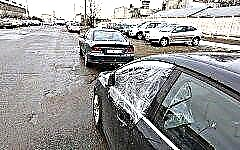

The content of the article:
- Traffic options
- Renovation work
- Random stone
- Who is to blame and what to do
Each driver at least once in his practice came across a stone that flew into the windshield from under the wheels of another car. This is a common problem that can occur on the central highway or secondary roads, at any time of the year and at any level of driver experience. The damage caused by the stone can be minor, in the form of a small chip, or it can completely break the glass.
What to do and who is to blame for this situation? Should I change the glass myself or can I find someone responsible for the trouble? Does insurance come into play here, or should the road services be sued?
Unfortunately, Russian citizens mostly have very weak legal knowledge, which, together with the inability to defend their rights, leads to unnecessary spending of the family budget on car repairs.
In the article, we will try to assure car owners that they should not rush to replace broken glass, because road workers can really be forced to compensate for the damage.
Traffic options
In order to correctly determine the culprit of the accident and the sequence of further actions of the injured car owner, two most common situations should be considered.
Renovation work

This is the most common and simplest scenario. For any road works of different scale and complexity, small and medium-sized crushed stone is gradually pulled apart along the entire road. He falls from the car that brought him, scatters in different directions while falling to the ground, small fractions are carried away by gusts of air from passing cars and are distributed over the entire road surface.
In this case, it is important to pay attention to the organization of the work and the equipment of the place of the repair team. Even before the start of the section where the repair is being carried out, an appropriate sign must be installed. Based on the category of the road and its speed limit, in the city the sign is installed 50-100 km from the beginning of the emergency section, in the suburbs for 150-300 km. Such a significant difference is explained by the higher speeds set outside the settlements, and therefore the driver and his car will need a longer distance to reduce the speed when approaching the place of repair.
By itself, this sign warns of the presence of obstacles on the road, speed limits and the likelihood of the release of rubble. Therefore, if the sign is not installed, installed at the wrong distance, or fell under the influence of the wind and is not visible to motorists, it is guaranteed that you can count on compensation from the road service.
Judicial practice shows that in most such cases, the law takes the driver's side and makes a decision on compensation for material damage.
If the driver is absolutely sure that he is right, then it will be mandatory to call the traffic police to fix the incident.
Road workers may show repair signs hung on construction equipment, but they are not legally warning signs of danger.
Almost certainly, the car owner will have to do an examination to confirm the cause of the crack or glass breakage. In any case, it will be useful, since it will subsequently be presented either in court or in an insurance company.
Random stone

In the traffic rules there is paragraph 10.1, which says about the driver's observance of the speed limit in adverse weather conditions, heavy traffic and other external factors. Thus, if the driver sees the presence of obstacles on the road in the form of stones, tree branches and other things, he must do everything possible to keep his car and neighbors intact on the road.
Although this cannot be called a standard accident, it is necessary to call the traffic police. The stone spoiled the appearance of the car, damaged important elements, which should be recorded in detail in the protocol. Without the police, the driver can say goodbye even to the hope of compensation.
After calling the traffic police order and drawing up a protocol on the commission of an accident, namely, the arriving stone is considered to be, the driver receives a certificate, with which he will then go to the insurance company. Unfortunately, not every insurance company agrees to take into consideration this atypical incident, which will take a long time to understand in order to identify the guilty party. Therefore, it is highly likely that the injured driver will have to defend their interests in court.
OSAGO against stone

So, we have already established that a stone hitting a car glass is a road traffic accident with material damage. The CTP policy insures, as you know, not the vehicle, but the liability of its owner. It seems that a logical conclusion follows that the driver, from under whose wheels the unfortunate stone flew, must be brought to justice. But not everything is so simple.
When a motorist moves at the prescribed speed, in his lane and observes traffic rules, and a stone accidentally comes across on his way, what can such a driver be blamed for?
That is why insurance companies do not tackle such situations, since the line between compliance and non-compliance with traffic rules is too thin.
A driver who wants to receive a refund using OSAGO will have to prepare a very powerful evidence base.
Thus, it is impossible to make an unambiguous conclusion about whether it is possible to compensate for the damage from the stone that got into the glass by means of the CTP policy. Each case is individual, requiring a long examination, collection of evidence, time spent and waiting for an unpredictable outcome.
Road workers against stone

Each section of the road is served by certain road services, is it possible to hold them accountable for damage from the presence of stones on their subordinate route?
Federal law regulating road safety has article 12, which lists the main requirements for the maintenance and repair of all routes. It clearly follows from it that the responsibility for monitoring the condition of roads of the corresponding category lies with the local executive authorities. If it turns out that it was not some truck that drove the stuck cobblestone in its treads, but that it was on the road for a while and was not cleaned by road services, then it is quite possible to force them to compensate for the damage.
Who is to blame and what to do

As follows from all the situations described above, the main difficulty lies solely in determining the origin of the stone. Road workers will vehemently deny their guilt, citing the appearance of a stone from the tread of a car. The insurance company, together with the injured party, will blame another motorist or road service.
Judicial practice shows the following picture: in most cases, the court refuses to pay MTPL, but often establishes the guilt of the organization serving the road. The number of proceedings on this issue is small to compile clear statistics, due to the irresponsibility of the car owners themselves.
Not seeing the obvious culprit and not having "corpus delicti", they do not consider it necessary to call the traffic police. But the incident report drawn up by the inspector is perhaps the most important argument containing information about the shortcomings of the road, the presence of rubble or a pit of an unacceptable size.
The right person during the proceedings will be determined only by the court, which can be very protracted and have negative consequences.











